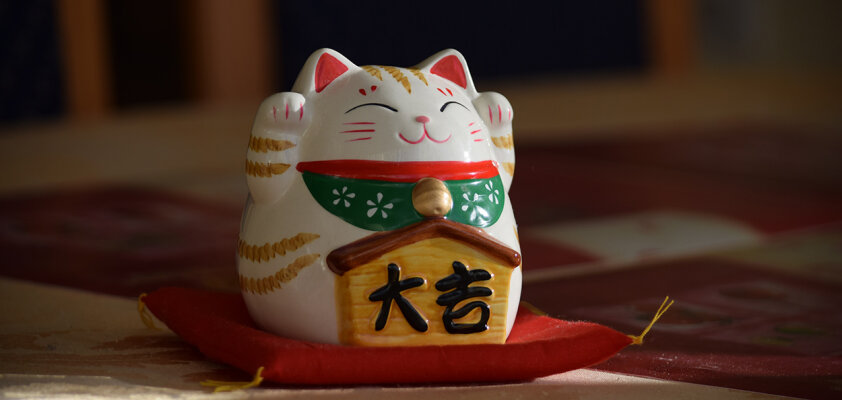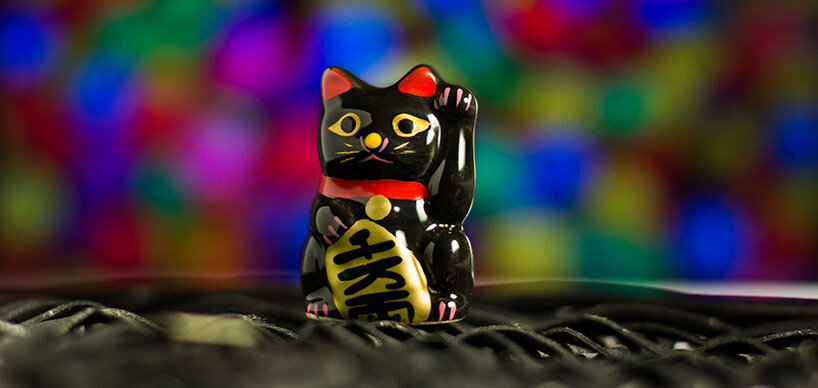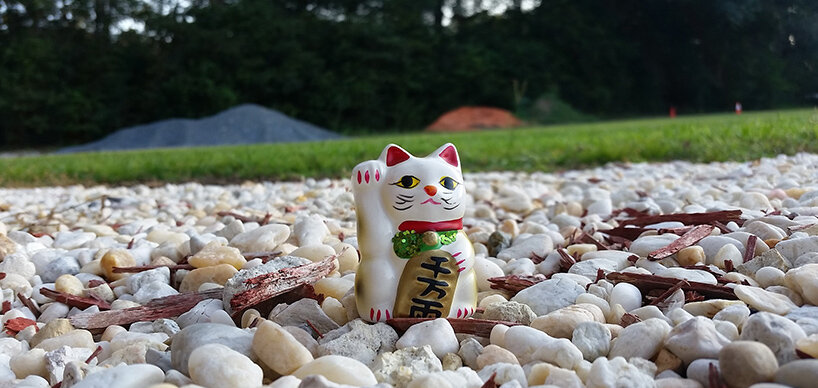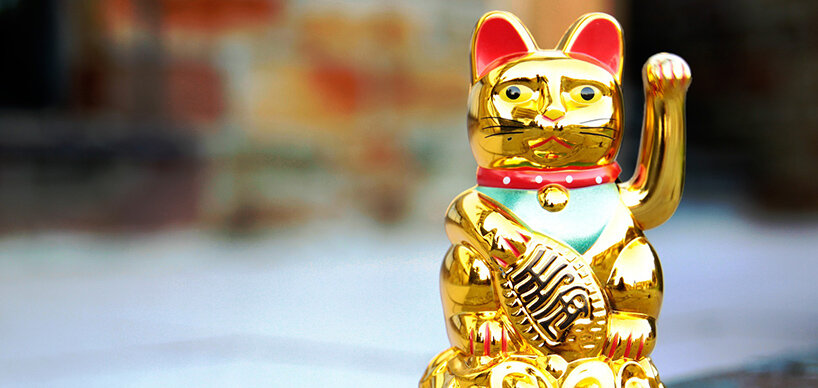Maneki-neko: The Cat that Beckons Luck

Sweet, traditional, or annoying? The smiling lucky charms often found in Chinese restaurants actually come from Japan. They not only serve as models for anime characters and mascots but also as a medium for traditions - yet are often misunderstood. Learn about the fascinating origin of these cat figurines and the reasons why they are actually endearing.
Small figure with many stories
Once upon a time, there was a poor monk in a small temple. He had only a tricolored cat named Tama as his companion, whom he always took good care of. One day, a rich lord passed by the temple on his way home as a storm began. Seeking shelter under a nearby tree, he noticed the cat at the entrance, waving its paw at him. Curiously, the lord entered the temple. At that very moment, a mighty lightning bolt struck the tree where he had stood. Tama had saved his life! Expressing his gratitude with a generous donation, the lord helped the monk rebuild his humble temple. It survived to this day and is now known as Gōtoku-ji - the Temple of Waving Cats.
The "waving" cat Tama was honored and immortalized in a figurine after its death. This is just one of the many legends surrounding the Japanese lucky cat. That's why today, hundreds of cat statues adorn the temple in the Setagaya district of Tokyo. Its peaceful location makes it a hidden gem for tourists who want to admire the many white ceramic lucky cats. Since the lord from the legend came from Hikone, the waving cat has become the mascot of the city.
Most of the tales about the origin of the waving cat date back to the Edo period (1603-1867). A slightly less fortunate story involves a geisha from Tokyo and her purring pet. One day, when the geisha was about to enter the bath, the cat suddenly behaved like it was rabid: it relentlessly attacked its mistress and pulled on her kimono. The owner of the house became frightened and, in a moment of panic, beheaded the cat with a sword mid-air. The head flew into the bath and hit – a snake. The cat's head, still in flight, bit and killed the reptile. The saved geisha was inconsolable, and in an attempt to bring her joy, the homeowner gifted her a small statue in the likeness of her beloved cat.
The color is the luck factor
In Japanese, the "waving cat" is called 招き猫 Maneki-neko and is often considered a reincarnation of Kannon, the Japanese goddess of mercy. When giving such a lucky cat a new home, one must first know which one to choose: they come in various colors. If it is typically white, it is said to bring extra joy and luck, while black wards off malevolent spirits.

Picture Credits: Author: Pierre Anquet | Flickr | License
Blue Maneki-neko are believed to provide security, and yellow ones help find the right partner, whether in love or business. Red is a protection against diseases, and a golden lucky cat symbolizes prosperity. Green and pink cats are a modern variation: green for success in education, pink for a happy love life. There are even waving cats with leopard prints today: they are said to bring success to politicians in elections. This is because the Japanese word Hyō for "leopard" sounds the same as the word for "voice."
Traditionally, the lucky cat is three-colored, just like its inspiration: the Japanese Bobtail. The breed originated in the Edo period at the imperial court, and its bobbed tail is believed to bring luck in Asian culture. The black-white-red tricolor variation of this breed is particularly rare and is believed to fulfill this role the best. Japanese Bobtail cats have a friendly character, making them a perfect inspiration. By the way, even the Japanese name for the real tricolored cat sounds similar: Mike-neko, "Three-Fur Cat."

What the Maneki-neko wears also holds significance. The popular mascot is usually adorned with a green apron and a red collar with a bell. The apron is meant to protect the small figure and show respect, while the collar with a bell is another symbol of wealth. Upon closer inspection, the lucky cat often holds something in the paw that is not waving. Whether it's a small hammer, an old coin from the Edo period, or a fish: each of these items represents prosperity.
The secret behind the Wink
Speaking of paws, it's known that the cat is beckoning something, but what exactly? To understand, one must pay attention to which paw is raised. The right paw is the one that waves for the owner's money, health, and luck. With the left paw, it often waves in shops and restaurants, inviting guests and customers into the establishment.
Even though it may seem like the lucky cat is waving goodbye to the observer, in Japan, one beckons someone by making a hand gesture with the palm facing downward and a paddling motion towards oneself. In the world of cats, it's the gesture for grooming. This was probably misinterpreted, leading to the tradition of the waving arm.
If the beckoning cat has both paws raised, it serves as a protector - whether in the family or in a business setting. Such lucky cats set records in sales during the 2008 financial crisis. Did they bring good fortune? Well, Japan's economy is currently growing at a rate not seen in a long time.
Where the lucky cat is at home
Not only in Gōtoku-ji can you find the Maneki-neko in Japan. Not far from the famous Sensō-ji in Asakusa, Tokyo, stands the Imado Shrine. At this shrine, people pray for finding a partner, so two huge white beckoning cats decorate the entrance. The Ema, small wooden plaques on which visitors write their wishes to the gods, are also adorned with lucky cats. But why Imado? The once flourishing pottery district produced some of the first beckoning cats, making it one of their birthplaces. Another legend comes from here: about a poor old woman who, with a heavy heart, had to sell her beloved cats. Instead, she made small clay cats, with which she could free herself from debt. According to local legend, this marked the beginning of the production of the popular Maneki-neko.
There are even museums dedicated to these figures - not just one. The largest is located in Seto in the southeastern Aichi Prefecture, where cat statues have been crafted in their refined style for over 1000 years. There, you can not only admire thousands of beckoning cats from different periods and styles but also create your own. On September 29, Seto hosts the grand Maneki-neko Festival: visitors paint themselves in the lucky cat style, and cat figures wave at them from every corner.
The neighboring city Tokoname is now the Japanese center of pottery and, therefore, the most important manufacturer of Maneki-neko. A huge stone figure of the lucky cat named Tokonyan reminds everyone of this: the nearly four-meter-tall mascot stands on a wall on Manekineko Street. Although the street is not officially named so, it's immediately recognized for what makes it special: the 39 small beckoning cat figures crafted by artists, adorning their wall.
Even the city of Takasaki in Gunma is known for producing various beckoning cats. The prefecture in the heart of Japan is even home to the Maneki-neko Association, which publishes a magazine. Hiroshima Prefecture is not spared from the popular figure either: a small museum in the city of Onomichi lies on the "Cat Path," also populated by real furry felines. For those who prefer to do something for their well-being, they can do so in the "Jazzbar Samurai" in Tokyo's nightlife district Shinjuku in the company of numerous lucky cat figures.
From Japan to the world
Chinesische Kaufleute brachten die Maneki-neko – bekannt als „Lucky Cat“ – in den letzten Jahrhunderten nach ganz Asien. Heute ist sie auch in China, Taiwan und Thailand vor allem als Geschenk bekannt und beliebt. Besonders chinesische Geschäftsleute schwören auf die goldenen Glücksbringer, die ihnen Reichtum bescheren sollen.

Mostly, the beckoning cat is made of ceramic or plastic today, sometimes even of porcelain, stone, or glass. Batteries or solar cells provide movement. For those annoyed by the waving paws, luck can be sought in other ways: Maneki-neko can be found as stuffed animals and keychains, piggy banks and stationery, and in many other forms. Even in pop culture: The cat figure has been the inspiration for Hello Kitty and the Pokémon Meowth. In Japan, traditions and modernity do not exclude each other.
In Japanese souvenir shops, you can find plenty of these small waving cats today, and they have often become kitschy trinkets for tourists. However, this does not do them justice. Understanding the origin and meaning of these Japanese good luck charms allows you to continue their beautiful tradition. Perhaps then, a Maneki-neko can beckon to you what you desire.











-from-the-yakiyaki-grill-pan.jpg)




